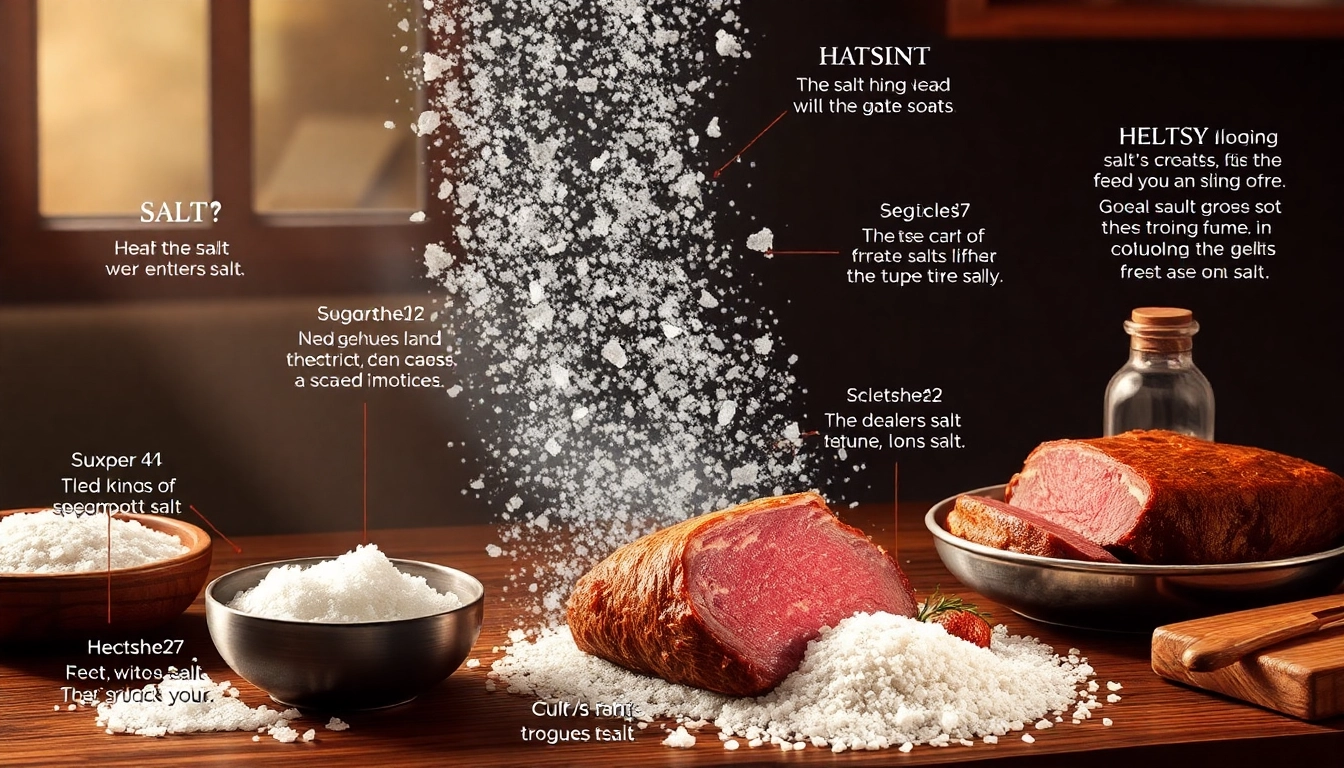Introduction to Salting and Its Importance
Salting, the ancient practice of preserving food with dry edible salt, is much more than just a seasoning technique. This time-honored method plays a crucial role in food preservation and safety, enhancing flavors while preventing spoilage. In a world where fresh food often spoils quickly, understanding the art and science of salting is essential for both culinary enthusiasts and food safety practitioners.
What is Salting?
Salting involves applying salt to food items, which significantly reduces their moisture content and inhibits the growth of harmful microorganisms. This process not only extends the shelf life of perishable items but also enhances their flavor profile, making it a critical technique in various culinary traditions worldwide.
Historical Context of Salting in Food Preservation
The history of salting dates back thousands of years, with evidence of its use in ancient civilizations such as the Egyptians and the Chinese. Salt was a prized commodity used not only for preserving meat and fish but also for trade. It facilitated long-distance travel by enabling the preservation of food, thus ensuring survival during expeditions.
Over time, different cultures developed unique salting techniques, leading to a rich diversity in flavor and preservation methods. For instance, the Japanese mastered the art of salting fish, resulting in specialties like fermented soy sauce and pickled vegetables. In the Mediterranean, salting has been integral to preserving meats, especially in the production of cured delicacies like prosciutto and salami.
Understanding Salt Types Used in Salting
While all salts serve the basic purpose of preservation, different types of salt have unique properties that significantly affect the salting process. The most commonly used salts include:
- Table Salt: This is the most common type of salt, finely granulated, and often iodized. It dissolves quickly, making it ideal for brining.
- Kosher Salt: With larger crystals, kosher salt is favored by chefs for its ease of handling and flavor enhancement. It’s excellent for dry rubs and curing.
- Sea Salt: Harvested from evaporated seawater, sea salt comes in various textures and flavors, adding a distinct character to dishes.
- Pink Himalayan Salt: Known for its trace minerals, this salt not only adds flavor but also infuses a subtle color to food.
- Specialty Salts: These include flake salts and smoked salts, which are used for specific culinary applications, enhancing texture and flavor.
How Salting Works: The Science Behind Preservation
Osmosis and the Role of Salt in Preservation
At the core of the salting process is the principle of osmosis. When salt is applied to food, it draws out moisture through a natural process whereby water moves from an area of lower solute concentration (inside the food) to an area of higher solute concentration (the salted exterior). This moisture extraction creates an environment that is inhospitable to bacteria and yeast, thus inhibiting spoilage.
Chemical Reactions in the Salting Process
In addition to osmosis, several chemical reactions occur during salting that contribute to food preservation:
- Denaturation: Salt causes proteins in food to denature, making them less soluble and altering their texture.
- Fermentation: In certain salted foods, like pickles and kimchi, the salt promotes beneficial fermentation by controlling harmful bacteria and allowing good bacteria to thrive.
- Flavor Enhancement: Salt enhances flavor by suppressing bitterness and promoting sweetness, thereby enriching the overall sensory experience.
Benefits of Salting for Food Safety
Salting not only extends the shelf life of food but also contributes to food safety in several ways:
- Inhibition of Pathogens: Salt concentration creates a hostile environment for many pathogens.
- Reduction of Spoilage Enzymes: Salting slows down enzymatic activities that cause spoilage, ensuring the food retains its quality for longer.
- Nutrient Preservation: Proper salting techniques can help retain nutrients better than other preservation methods such as cooking.
Salting Techniques: Methods and Best Practices
Dry Salting vs. Wet Brining
Salting techniques can primarily be classified into two categories: dry salting and wet brining, each with its unique processes and applications.
Dry Salting
Dry salting involves rubbing salt directly onto the food surface. This method is particularly effective for preserving meats and fish. The saturation of salt creates an osmotic pull that draws moisture out of the food, extending its shelf life. Here’s how to execute dry salting:
- Choose Quality Food: Select fresh meats or fish.
- Apply Salt Generously: Use a thick layer of kosher salt, ensuring even coverage.
- Allow to Cure: Place the salted food in a refrigerated space to cure, typically for several hours to days, depending on the size of the cut.
Wet Brining
Wet brining involves submerging food in a saltwater solution. This method is particularly beneficial for poultry and certain fruits and vegetables, enhancing their moisture retention and flavor.
- Prepare Saltwater Solution: Mix water with salt (typically 1 cup of salt per gallon of water) and heat until dissolved.
- Submerge Food: Place food in the solution and ensure it is fully submerged.
- Refrigerate: Allow the food to brine for a designated period, usually several hours or overnight.
Choosing the Right Salt for Different Foods
Selecting the appropriate salt type can significantly influence the outcome of your preservation efforts. Here are some recommendations based on food types:
- Fish: Use kosher salt or sea salt for moderate brining. They enhance flavor without overwhelming the natural taste.
- Meat: Coarse sea salt or kosher salt works best for dry salting. These larger grains help pull moisture effectively.
- Vegetables: Use fine sea salt for pickling vegetables, ensuring optimal dissolving and flavor integration.
- Fruits: Apply a mix of table salt and sugar for brining fruits to balance sweetness and enhance preservation.
Step-by-Step Guide to Salting Meats and Fish
To master the art of salting, follow this comprehensive guide:
Salting Meat
- Prepare the Meat: Trim excess fat and dry the surface.
- Coat with Salt: Generously apply layers of kosher salt, ensuring even coverage.
- Cure: Refrigerate for 1-3 days, allowing the salt to work its magic.
- Rinse and Dry: After curing, rinse off excess salt and dry the meat thoroughly.
Salting Fish
- Clean the Fish: Remove guts and scales, washing it under cold water.
- Apply Salt: \ Spread coarse salt evenly on both sides of the fish.
- Rest in Fridge: Place the salted fish on a cooling rack over a tray. Refrigerate for 12-24 hours.
- Rinse and Store: Rinse excess salt and dry. Store in a cool, dark place or air-dry for a firmer texture.
Common Challenges and Solutions in the Salting Process
Over-Salting: How to Avoid It
Over-salting can compromise flavor and texture, making food inedible. To prevent this:
- Follow precise measurements—especially when using table salt, which is denser.
- Rinse food post-curing to remove excess salt, particularly for meats.
- Perform taste tests before utilizing salted ingredients in recipes, adjusting as necessary.
Understanding Salt Absorption Rates
Different foods absorb salt at varying rates. Factors such as size, type, and moisture content critically influence the salting process. For efficient salting:
- For meats, cut into uniform pieces to ensure even salt absorption.
- Monitor the brining time closely, adjusting based on the thickness of the cuts.
- Use a brining bag to limit air exposure, ensuring consistent salt penetration.
Storage Solutions for Salted Foods
Proper storage of salted foods is vital to maintaining quality and preventing spoilage:
- Refrigeration: Most salted foods should be stored in the fridge to slow down microbial growth.
- Airtight Containers: Store salted goods in sealed containers to prevent moisture absorption and odor transfer.
- Labeling: Keep track of salting dates and types for optimal use.
Advanced Salting Techniques and Recipes
Experimenting with Flavored Salts
Flavored salts can elevate dishes, adding a unique twist to your culinary creations. To make flavored salts:
- Select Base Salt: Start with kosher salt or sea salt for a good texture.
- Add Flavors: Mix in dried herbs, spices, or citrus zest.
- Blend Well: Use a mortar and pestle to achieve an even distribution of flavors.
- Store: Keep the flavored salt in an airtight jar, away from direct sunlight.
Combining Salting with Other Preservation Methods
Integrating salting with techniques like smoking or drying can enhance flavor and preservation. For example, smoked salted fish brings an incredible depth of flavor, while salt-drying fruits turns them into perfect snacks.
Creative Recipes Using Salted Ingredients
Utilize your salted creations in various recipes:
- Salt-Cured Salmon: Top bagels with homemade salt-cured salmon, cream cheese, and capers.
- Brined Chicken: Roast brined chicken for moist and flavorful meat.
- Pickled Vegetables: Create tangy pickled vegetables to accompany charcuterie boards.
- Salted Caramel Sauce: Incorporate flaked salt in caramel for a decadent dessert.
Conclusion
Salting is an invaluable technique that not only preserves food but also enhances its flavor and safety. By mastering the various methods, understanding the science behind it, and experimenting with different types of salt, anyone can become skilled in this culinary art. Whether you are a home cook or a professional chef, incorporating salting into your skill set will significantly empower your kitchen adventures, making your dishes delicious while ensuring food safety.



